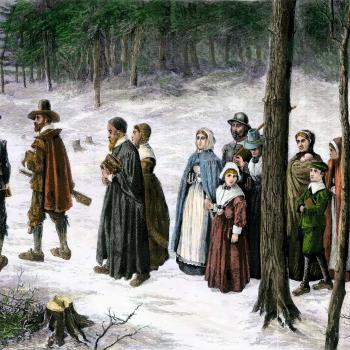Remember that little Lydia Schatz, disciplined to death by her parents, was adopted from Liberia? Well, this wasn’t an abnormality. It was actually kind of a thing in quiverfull homeschooling families. I knew this as a kid because I noticed the trend in quiverfull publication Above Rubies magazine, which my family began subscribing to sometime in the 1990s. Throughout the early and mid 2000s, this magazine was peppered with images of families like the one shown above, this one a photo of Above Rubies founder Nancy Campbell’s daughter Serene’s family. Serene and her husband adopted a total of six Liberian orphans, three of them in their teens at the time of adoption, and large numbers of quiverfull families followed suit on Nancy Campbell’s urging. Many of these families graced the cover of Above Rubies, and also, given the overlap in readership, the cover of the Pearls’ No Greater Joy magazine.
I suppose I shouldn’t be surprised that we’re now hearing just what became of those children—and that it’s not pretty. Lydia Schatz’ death at the hands of her adoptive parents may have been extreme, but it appears that abuse and failed adoptions were common among the quiverfull families who snapped up literally hundreds of Liberian orphans at Nancy Campbell’s urging. This is the revelation of Kathryn Joyce, who published an article yesterday in Mother Jones, an excerpt of what is to come in her forthcoming book on the topic.
I might have been more surprised at what I read in Joyce’s article had I not already read the hundreds of stories posted on a site called Pound Pup Legacy. This Pound Pup Legacy link—which you shouldn’t read unless you have a firm stomach—details story after story of children abused in their adoptive homeschooling families. They were beaten with electrical wire, locked in cages, forced to sleep outside without blankets, and deprived of food—and much, much more. When I came upon this link a month ago, I had to take numerous breaks and in the end never finished reading through all of the stories. I just couldn’t. I had, before this, thought that the stories of Lydia Schatz and Hana Williams, who was adopted from Ethiopia before dying of exposure after being locked outside of her adoptive family’s house in November as punishment for disobedience, were anomalies. When I came upon that terrible, terrible link, I learned that this was not the case.
But when I read Joyce’s article, what really hit me was that these were the people whose sunny stories covered the pages of Above Rubies magazine, the stuff of my childhood. I poured over Above Rubies magazine as a teen, drinking it up. It was all there—large homeschooling families, happy homemakers, a back-to-basics homesteading lifestyle. It was so idyllic, when I read it, so picture perfect. And now, with this one article, that perfection is dashed. It turns out that when you combine the adoption of children from a war-torn foreign country in order to evangelize them, on the one hand, with extremely strict ideas about discipline and submission to parents, on the other, the potential for disaster is enormous. And now I feel like I have to go back and go over each of those memories again, taking this new knowledge into account.
Here is an excerpt from Joyce’s article, which you should read in full:
IN 2005, SAM ALLISON, a Tennessee housepainter in his 30s, arrived at Daniel Hoover Children’s Village, an orphanage outside Monrovia, Liberia. He’d come to adopt three children, but ended up with four: five-year-old Cherish; her nine-year-old brother, Isaiah; their 13-year-old sister, CeCe, who had taken care of them for years; and Engedi, a sickly infant whom Sam and an adoption broker had retrieved from “deep in the bush.” The older children’s father had sent them to Daniel Hoover during Liberia’s 14-year civil war, after their mother died in childbirth. The orphanage, run by a ministry called African Christians Fellowship International, often ran short of food, and schooling was sporadic. The children, who were forced to flee temporarily when rebels attacked the facility in 2003, referred to America—whose image looms large in a country colonized by freed slaves in the 19th century—as “heaven.”
In Tennessee, Sam and the four adoptees joined his wife, Serene—a willowy brunette who’d attempted a career in Christian music—and their four biological children. Together they moved into a log cabin in Primm Springs, a rural hamlet outside Nashville. Serene welcomed the children with familiar foods such as rice, stew, and sardines, and they were photographed smiling and laughing.
The cabin adjoined a family compound shared by Serene’s parents, Colin and Nancy Campbell, and the families of Serene’s two sisters. Colin is the pastor of a small church and Nancy a Christian leader with a large following among home-schoolers. Her 35-year-old magazine, Above Rubies, which focuses on Christian wifehood, has a circulation of 130,000 in more than 100 countries—mostly fundamentalist Christian women who eschew contraception and adhere to rigid gender roles. The aesthetic is somewhere between Plain People austerity and back-to-the-land granola, with articles like “Plastic or Natural?,” “Raising Missionaries,” and “Green to Go,” featuring recipes for concoctions like “green transfusion” and “My personal earth milk.” In a Facebook photo, Nancy twirls in a tie-dyed peasant skirt. Her daughters, striking women with waist-length hair, use Nancy’s magazine to peddle motherhood-themed CDs and health and lifestyle books with titles such as Trim Healthy Mama. It’s an extended family that thousands of home-schooling mothers know nearly as well as their own.
In 2005, Above Rubies began advocating adoptions from Liberia, arranged through private Christian ministries. Campbell—whose magazine likened adoption to “missions under our very own roof!”*—spent a week visiting Liberian orphanages and returned with “piles of letters addressed ‘To any Mom and Dad.'” She touted the country’s cost-effectiveness—”one of the cheapest international adoptions”—and claimed that 1 million infants were dying every year in this nation of fewer than 4 million people. “When we welcome a child into our heart and into our home,” she wrote, “we actually welcome Jesus Himself.”
Campbell urged readers to contact three Christian groups—Acres of Hope, Children Concerned, and West African Children Support Network (WACSN)—that could arrange adoptions from Liberian orphanages. At the time, none of these groups was accredited in the United States as an adoption agency, yet they all placed Liberian children with American families for a fraction of the $20,000 to $35,000 that international adoptions typically cost. Before long, members of a Yahoo forum frequented by Above Rubies readers were writing that God had laid the plight of Liberian orphans heavy on their heart. “Families lined up by the droves,” one mother recalled. They “were going to Liberia and literally saying, ‘This is how much I have, give me as many as you can.'”
The magazine’s Liberia campaign, it turned out, heralded an “orphan theology” movement that has taken hold among mainstream evangelical churches, whose flocks are urged to adopt as an extension of pro-life beliefs, a way to address global poverty, and a means of spreading the Gospel in their homes. The movement’s leaders, as I discovered while researching my upcoming book on the topic, portray adoption as physical and spiritual salvation for orphans and a way for Christians to emulate God, who, after all, “adopted” humankind. Churches reported that the spirit was proving contagious; families encouraged one another to adopt, and some congregations were taking in as many as 100 children. Dozens of conferences, ministries, and religious coalitions sprang up to further the cause, and large evangelical adoption agencies such as Bethany Christian Services reported a sharp increasein placements at a time when international adoptions were in decline.
Within months of launching her Liberia campaign, Campbell reported to her readers that 70 children were in the process of being adopted through African Christians Fellowship International, most to families that were already large, with some taking as many as five or six. She recalled helping one adoptive father navigate Washington, DC’s Dulles airport with his new Liberian triplets; she put one of them, a wide-eyed infant named Grace, with bow lips and a Peter Pan collar, on the cover of the magazine. Campbell adopted four children herself, and Serene took a total of six. “From my article in Above Rubies about the children in Liberia there must have been up to a thousand children adopted,” Campbell informed me in an email, “and most have been a blessing.”
FOR PATTY ANGLIN, the cofounder of Acres of Hope, one of the groups promoted by Above Rubies, the campaign’s impact and Campbell’s characterization of the adoptions as “cheap, easy and fast” proved jarring. “So many people responded, and they were responding at an alarming rate,” she recalled.
In part, Anglin was worried because she knew how complicated things could get in Liberia, a nation that had only recently emerged from its civil war and was still in a state of near lawlessness. Given the conditions there, the prospect of a $6,000 adoption fee was enough to attract some shady operators. Adoptions that took a year to process in other countries could happen in weeks or days in Liberia, and bribery was rampant. Liberian parents began complaining that adoption had been misrepresented to them as some sort of temporary education arrangement—one local orphanage staffer proclaimed that his own children had been adopted and were now “benefiting from the program,” according to AllAfrica.com. WACSN, one of the agencies Campbell promoted, would eventually host a contingent of American preachers for a three-day revival in Monrovia. The organizers urged believers back home to get involved by adopting through WACSN, which had declared that it would only serve biblical literalists. The struggling Liberian government was able neither to keep tabs on children leaving the country nor to distinguish licensed adoption agencies from groups that merely had nonprofit status.
All was not harmonious in Primm Springs either, according to the four Allison adoptees I interviewed at length for this story. (Sam Allison has denied all of their allegations.) “Everything was good for a month,” CeCe, now 21, told me. “We got to the next month and things started to get a little weird.” Serene’s raw-food offerings were unfamiliar, but Sam would discipline them if they balked at eating her meals, the children said. Other cultural impasses included the children’s use of Liberian English and the Liberian prohibition on children looking adults in the eye. “They’d say, ‘You are so rude. I’m talking to you!'” CeCe recalled. “They expected us to adapt in a heartbeat.”
In October 2006, a year after their first Liberian adoptions, the Allisons adopted another pair of siblings: Kula, 13, and Alfred, 15. “In Africa we thought America was heaven,” recalled Kula, who is 19 now. “I thought there were money trees.” Primm Springs was a rude awakening: It was dirty, she recalled, and she had no toothbrush. The new house Sam was building—with the older kids working alongside him—often lacked electricity. There was only a woodstove for heat, and no air conditioning or running water yet. Toilets were flushed with buckets of water hauled from a creek behind the house. The children recalled being so hungry that they would, on occasion, cook a wild goose or turkey they caught on the land. “We went from Africa to Africa,” CeCe said.
They didn’t attend school, either; home schooling mostly consisted of Serene reading to the younger children. When the older kids watched a school bus drive past on a country road and asked why they couldn’t go, they were met with various excuses. So Isaiah and Alfred worked with Sam in his house-painting business or labored in Nancy Campbell’s immense vegetable garden while CeCe, Kula, and Cherish cleaned, cooked, and tended to a growing brood of young ones. It was also the job of the “African kids,” as they called themselves, to keep a reservoir filled with water from the creek. CeCe hadn’t yet learned to read when Serene gave her a book on midwifery so she could learn to deliver their future babies. “They treated us pretty much like slaves,” she said. It’s a provocative accusation, but one that Kula and Isaiah—as well as two neighbors and a children’s welfare worker—all repeated.
Discipline included being hit with rubber hosing or something resembling a riding crop if the children disrespected Serene, rejected her meals, or failed to fill the reservoir. For other infractions, they were made to sleep on the porch without blankets. Engedi, the toddler, was disciplined for her attachment to CeCe. To encourage her bond with Serene, the Allisons would place the child on the floor between them and CeCe and call her. If Engedi went to CeCe instead, the children recalled, the Allisons would spank her until she wet herself.
And that’s where I’m going to stop. Do go read the whole thing, if you can stomach it. I have to be honest, that last paragraph there had me in tears. I honestly can’t believe that this was allowed to happen. My heart aches for those children.














